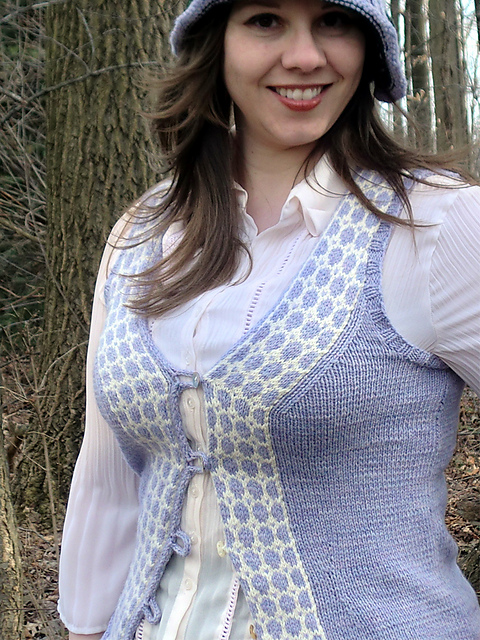After that little venture into sock patterns last month, I decided that it was time for a change and that a vest would be a good project. Presenting Daughter of the Sea, knit in Cascade 220 Heathers, color 2422 (lavender) with trim in Cascade 220 Wool, color 8010 (cream). The lavender yarn is the same color that was used in the Larkspur Lane socks; they'd make a good set, don't you think?
The pattern name is the translation of the Latin name Cordelia, much favored by Anne of Green Gables. I originally intended to call the vest Cordelia, but there were already a number of patterns with that name, and confusion isn't such a good thing. Enter the translation "Daughter of the Sea," which seemed appropriate because of the mother of pearl buttons used to fasten the vest. Matching buttons are used on a small decorative belt used to accent the back.
Main yarn: Cascade 220 Heathers, 100% Peruvian highland wool, 220 yd / 200 m, color 2422 (lavender) - 3 (3, 4, 4, 5) 5 skeins or about 560 (650, 800, 880, 1000) 1200 yd / 515 (600, 735, 805, 915) 1100 m of any worsted weight yarn.
Contrast yarn: Cascade 220, 100% Peruvian highland wool,
220 yd / 200 m, color 8010 (cream) - 1 (1, 1, 1, 1) 1 skein or about 105 (110, 115, 115, 120) 130 yd / 96 (100, 105, 105, 110) 120 m of any worsted weight yarn.
Notions: Stitch holder, yarn needle for weaving in ends, 7 buttons (shown: Favorite Findings “Shellz,” 5/8”, #1801), sewing needle & thread for attaching buttons.
Construction: Worked flat from the bottom up, then seamed. Stitches are picked up for armhole ribbing, which is worked in the round. Attached I-cord is worked around the hem and front openings.
Skills: Knitted cast-on, knit, purl, increasing, decreasing, stranded colorwork, following a chart, picking up stitches, I-cord.
Notes: The vest is designed to be worn with zero or negative ease. Choose the size nearest your actual bust measurement. Read through the pattern before beginning; neck shaping and armhole shaping are worked at the same time. For a less fitted silhouette, waist shaping may be omitted. Photos show size Medium.
Daughter of the Sea: $6.95 from
Ravelry or
Patternfish
 Dear Allfreeknitting.com,
Dear Allfreeknitting.com,





